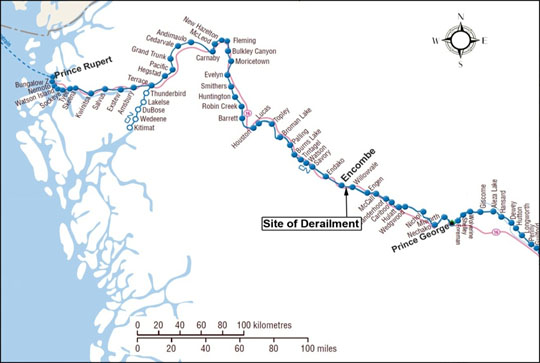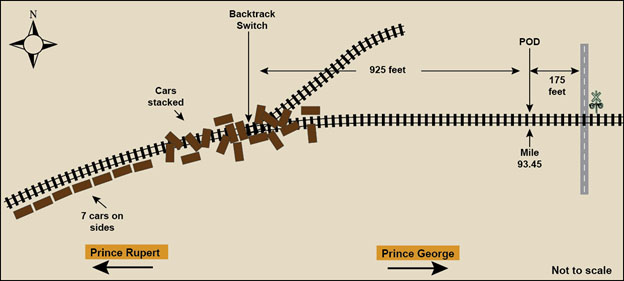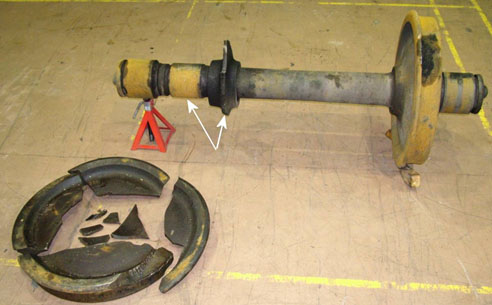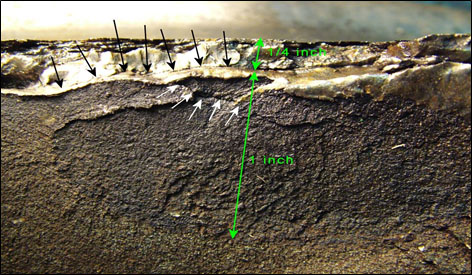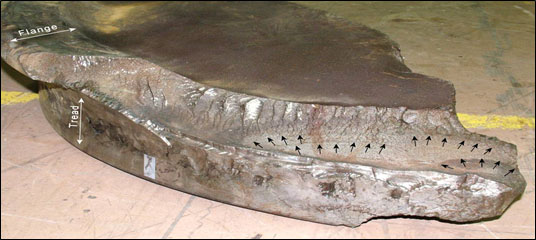Main-track train derailment
Canadian National
Train C751-51-11
Mile 93.45, Nechako Subdivision
Fort Fraser, British Columbia
The Transportation Safety Board of Canada (TSB) investigated this occurrence for the purpose of advancing transportation safety. It is not the function of the Board to assign fault or determine civil or criminal liability. This report is not created for use in the context of legal, disciplinary or other proceedings. See Ownership and use of content. Masculine pronouns and position titles may be used to signify all genders to comply with the Canadian Transportation Accident Investigation and Safety Board Act (S.C. 1989, c. 3).
Summary
On 12 February 2011 at approximately 1745 Pacific Standard Time, Canadian National Unit Coal Train C 751–51–11, travelling westward on the Nechako Subdivision at about 45 mph, experienced a train–initiated emergency brake application at Mile 93.45, near Fort Fraser, British Columbia. Upon examination, it was determined that a total of 36 cars had derailed, from the 43rd car to the 78th car inclusive.
Ce rapport est également disponible en français.
Factual information
On 12 February 2011 at approximately 1745,Footnote 1 Canadian National (CN) Train C 751–51–11 (the train), travelling westward on the Nechako Subdivision at 45 mph, experienced a train–initiated emergencyFootnote 2 brake application at Mile 93.45, near Fort Fraser/Encombe, British Columbia (Figure 1). The train comprised 2 head–end locomotives and 104 loaded coal cars. It weighed 9873 tons and was 10 678 feet in length. It was a unit coal train that travelled from Tumbler Ridge, British Columbia, where the cars are loaded, to Prince Rupert, British Columbia, where the cars are unloaded, a distance of approximately 611 miles. The crew consisted of a locomotive engineer and a conductor. Both crew members were qualified for their respective positions, were familiar with the territory, and met established fitness and rest standards.
While investigating the source of the emergency brake application, the conductor discovered a broken coupler knuckle. The conductor was changing the broken knuckle when he was contacted by the rail traffic controller and advised that there was a report of derailed cars on the main track. Upon further examination, the conductor determined that a total of 36 cars had derailed, beginning with the 43rd car of the train, up to and including the 78th car.
Nechako subdivision
The Nechako Subdivision begins at Prince George (Mile 0.0) and extends westward ending at Endako (Mile 115.4). Train movements on this subdivision are governed by the Centralized Traffic Control System (CTC) as authorized by the Canadian Rail Operating Rules and supervised by a rail traffic controller located in Edmonton, Alberta. The zone speed for freight trains through the derailment area was 45 mph.
Site examination
The point of derailment (POD) was determined to be about 175 feet west of the public crossing located at Mile 93.40. No marks were found on the rail head leading up to the POD. However, at the POD, there were marks on the ties to the field side of the north rail.
It was determined that the L2 wheel on the 62nd car, BCNE 900534, had broken and derailed to the field side of the north rail. The car then travelled approximately 925 feet where it encountered a track switch for a backtrack, precipitating the main derailment. In addition to the 62nd car, 19 cars in front (west) and 16 cars behind (east) derailed (Figure 2). The 19 cars ahead (west) derailed in a string–line fashion with 7 cars (that is, 43rd to 49th) on their sides in the body of the curve and the remaining 12 in various positions behind them.
The broken wheel (L2 wheel) on car BCNE 900534 was sent to the TSB Laboratory for further examination.
Track information
In the vicinity of the derailment, the track had curves of varying degrees and a descending grade to the west ranging from 0.4 to 0.1%. The track consisted of 136–pound continuous welded rail on double–shouldered tie plates with 4 spikes per plate and Fair anchors every second tie. The ties were hardwood on the curve with approximately 3100 ties per mile, supported by 2 ½ inch AREMAFootnote 3 5 ballast, 12 inches underneath and at the shoulders. The drainage was good.
On 11 February 2011, the track supervisor had conducted a visual inspection of the track in the area of the derailment and no defects were noted. On 04 February 2011, the track supervisor had conducted a visual inspection. In addition, a track geometry test car inspection had been conducted. The inspections revealed no defects in the vicinity of the derailment.
Certified car inspection for train 751
In the train service plan for train 751, a certified car inspection (CCI) is scheduled in Prince George for the return (empty) portion of the trip cycle. The cars travel approximately 1180 miles between CCIs. Before the derailment, the most recent CCI had taken place on 02 February 2011.
Recorded information
Based on the locomotive event recorder (LER) download,
- the train was travelling at 45 mph at the time of the emergency brake application;
- the train speed was being controlled using only the locomotive dynamic brake Footnote 4 (DB) for approximately 3.5 miles before the emergency brake application;
- the DB manipulations varied from DB position 3 through DB position 8 (maximum); and
- train speed was maintained at 45 to 46 mph for the 3.5 miles before the emergency brake application.
The first derailed car
Car BCNE 900534 was a coal open–top rotary gondola. It measured 58 feet 7 inches long and was 11 feet 11 inches high and 10 feet 8 inches wide and had a maximum gross rail weight of 286 000 pounds. The tare weight (that is, weight of the car empty) was 56 700 pounds, giving it a load limit of 229 300 pounds. A review of the scale tickets indicated that the car had been loaded to 203 540 pounds for this trip.
The broken wheel
The L2 wheel of the No. 2 wheel set was manufactured in March 2006 by the Griffin Wheel Company in Winnipeg, Manitoba. It was a 1–wear, cast, wide–flange contour, and heat–treated wheel. This wheel set had been placed under the car during a repair on 17 May 2006. An initial examination of the wheel (Photo 1) determined the following:
- The rim had fractured in four places.
- The hub of the fractured wheel was still on the axle (see arrows in Photo 1), but it had been forced inboard off its seat.
- The bearings adjacent to the fractured wheel and the non–fractured mating wheel were examined visually and they did not exhibit any indications of damage.
- The fractured wheel did not exhibit a rust–coloured band around its perimeter to suggest it had been overheated.
- The tread of the fractured wheel exhibited a large number of shells extending all around the circumference of the wheel. The larger shells were very close to the Association of American Railroads (AAR) maximum allowable limit, but did not exceed it.
- The shelling damage at the origin of the progressive fracture did not appear to be significantly worse than elsewhere on the tread. The tread surface of the L2 wheel also exhibited small surface cracks inclined at 45°.
- On the mate wheel, shelling was limited to a region approximately 12 inches long. This shelling did exceed both the AAR and Transport Canada's (TC) allowable limits.
- Apart from the shelling, the treads of both wheels were otherwise undamaged and they did not exhibit thermal cracks.
Rolling contact fatigue and shelling
Rolling contact fatigue of railway wheels is caused by repeated contact stress between the wheel and the rail during rolling motion. There are 3 common rolling contact fatigue mechanisms:
- Surface–initiated fatigue—This process stems from the severe plastic deformation of the surface material. Once a crack initiates in the surface layer, it propagates at a shallow angle down into the wheel and backs up to the tread such that it normally results in the detachment of a small piece of the tread material, referred to as a shell. Footnote 5
- Subsurface–initiated fatigue—This usually initiates approximately ¼ inch below the tread surface. This process is caused by a combination of high vertical loading and locally low fatigue resistance of the material such as that resulting from microscopic manganese sulphide inclusions. Once a crack initiates in the subsurface layer, it initially grows parallel to the tread. There are usually no macroscopic inclusions or voids at the point of initiation.Footnote 6
- Fatigue initiated at deep material defects—This usually initiates approximately ½ to 1 inch below the tread at macroscopic defects or voids about 1 mm in size and grows parallel to the tread. Final fracture results from branching of the circumferentially growing crack.Footnote 7
The first 2 rolling contact fatigue mechanisms can lead to shelling of the tread surface. This shelling can be further influenced by the reduction in material strength associated with elevated temperature due to braking.
Vertical split rims and broken wheels
Researchers continue studying vertical split rim (VSR) as it is not completely understood. VSR tends to start at the bottom of a rolling contact fatigue–initiated shell or spall Footnote 8 and is one of the dominant railway wheel failure types observed in North America.Footnote 9
CN estimates that there are over a million different wheels each year in operation on its lines (Canada and United States). In 2011, CN identified and removed 55 wheels on its system that were categorized as “broken.” Among the 55 wheels, 8 resulted in a derailment and 4 of these were minor events involving only 1 car.
Laboratory analysis of broken wheel
- Laboratory analysis of the L2 wheel on car BCNE 900534 determined the following:
- The wheel fractured due to a VSR that extended around approximately ¼ of the wheel circumference. The VSR originated approximately ¼ inch below the tread surface along the bottom of a shell (Photo 2).
- The subsurface crack parallel to the tread that caused the shell was visible. There was also a secondary crack extending from the bottom of the shell, perpendicular to the tread, downward into the wheel.
- The L2 wheel was shelled all around its circumference and exhibited multiple surface and subsurface cracks, indicating significant rolling contact fatigue crack growth activity (Photo 3). The VSR had originated at the base of such a shell. The shelling was not considered to be condemnable under AAR standards.
- No metallurgical defects that would have led to the failure were observed at the origin.
- The wheel hardness, chemical composition, microstructure, rim wear, flange wear, and hollow tread wear met the requirements of the applicable AAR standards.
- The failed wheel did not meet the applicable AAR microcleanliness standard for the worst field oxides and voids. It was not possible to quantify how significant this deviation was in contributing to the failure.
- Factors contributing to rolling contact fatigue and VSR failures include the regular service load, unusual impact loads, the number of service cycles, the condition of the rail surface, residual stress in the wheel, the wheel material microcleanliness, and the presence of other defects or damage. It was not possible to determine the relative importance that each of these factors had in contributing to the failure.
Association of american railroads and Transport Canada standards for shelled wheel defects
In Canada, Transport Canada (TC) standards are applied by federally regulated railways during CCIs to determine if there are any defects that would not allow a piece of railway rolling stock to continue in service. When a car is on a repair track, the AAR standards are used as the criteria for determining what may be a condemnable defect. With respect to the size of a wheel shell before it is condemnable, the AAR and TC have differing limits.
For the AAR, before July 2002, Rule 41 stated:
When the shell or spall is ¾ inch in diameter or larger and the shells or spalls are more or less continuous around the periphery of the wheel or whenever any shell or spall is 1 inch or more in diameter, the wheel must be removed from service. Islands of original tread surface metal contained in the shell or spall will not be considered as part of the area of the shell or spall.
Rule 41 was modified in July 2002 as follows:
Whenever any shell or spall is 1 inch or more in diameter, the wheel must be removed from service. Islands of original tread surface metal contained in the shell or spall will not be considered as part of the area of the shell or spall.
The change was prompted due to ambiguity of the rule (that is, interpretation of "more or less continuous"). In addition, it was believed that, with the installation of wheel impact load detectors (WILDs), the risks associated with circumferential shelling had been reduced.
For TC, the standard for condemning a wheel due to shelled tread states that "A railway company may not place or continue a car in service if: a wheel has a shelled spot that is more than 1 ¼ inches in width and 1 ½ inches in length."
The TC standard does not include any reference to islands of original tread surface metal contained in the shell or spall.
Wheel impact load detectors
WILDs are wayside devices that measure the impact load of a wheel on the rail usually through a strain–based or accelerometer–based system. The strain–based system quantifies the force applied to the rail through a mathematical relationship between the applied load and the deflection of the rail. These gauges are physically mounted on the web of the rail, about halfway down from the top of the rail head. Strain in the rail is used as a direct measure of the load at the rail head.
At CN, in cars with a WILD reading of 140 kipsFootnote 10 or more, the subject wheel must be replaced before the car is put back in service. Impacts between 90 and 140 kips are considered maintenance level wheel impacts. These cars are flagged and may or may not be forwarded for subsequent inspection by qualified staff at the next available terminal. The kips levels at which these wheels are flagged are adjusted due to factors such as weather (i.e., higher incidence of shells in the winter) to balance the maintenance workload and system operations. Wheels identified with maintenance level wheel impacts are changed out at the earliest opportunity.
CN has invested in one of North America's largest networks of WILDs (that is, 39 detectors at 34 sites). Using this network of WILDs, CN removes between 25 000 to 30 000 wheels each year for wheel impacts in the range of 90 kips to 139 kips. According to CN, the majority of these wheels were relatively close to the 90–kip threshold. About 2500 wheels per year escalate to wheel impact levels above 140 kips. These above–140 kips wheels often show little in their history, indicating that the deterioration of the wheel tread surface can be very rapid, often while the car is in transit to the maintenance location. Details of CN's WILD policy are summarized in Appendix A.
The AAR, in its 2011 standards, permits the optional removal of a wheel when the single wheel impact readings are 90 kips or greater. However, when a car is on a repair track for any reason and a single wheel has had a reading between 80 kips to 90 kips, the wheel is considered condemnable and must be removed.
TC–approved Railway Freight Car Inspection and Safety Rules do not have any provision for condemning in–service wheels due to WILD readings.
Wheel impact load detector readings and vertical split rim wheel failures
In a study conducted by the Transportation Technology Center, Inc.Footnote 11 involving 24 wheel sets with broken wheels, it was determined that the dominant failure mode (71%) was VSR. In 6 of the 12 broken wheels for which historical WILD data were available, there had been impact loads exceeding 90 kips before the failure.
Less than 3 hours before the derailment, the L2 wheel on car BCNE 900534 recorded a WILD reading of 94.4 kips at a WILD site, approximately 78 miles from the site of derailment. On 3 other occasions, impacts of over 80 kips were measured for this wheel: 83.2 kips on 24 December 2010, 81.2 kips on 08 January 2011 and 87.8 kips on 08 February 2011. The WILD readings for the R2 wheel (the mate wheel) were well below the 90–kip threshold.
In 2 recent Transportation Safety Board of Canada (TSB)–reportable occurrences involving broken wheels that were not the subject of formal TSB investigations (that is, R11T0072—Coport, Ontario, and R11T0079—Makwa, Ontario), the circumstances leading to the wheel failures were reviewed with respect to WILD histories. In the case of R11T0072, the occurrence wheel had recorded impact readings over the AAR limit on 8 occasions before failing. In the case of R11T0079, the wheel impact loads never reached the AAR limits before failing. The failed wheels from both of these occurrences were secured and sent to the TSB Laboratory for detailed examination.
The following TSB Laboratory reports were completed:
- LP037/2011 (R11T0072 - Coport)
- LP040/2011 (R11T0079 - Makwa)
- LP022/2011 (R11V0039 - Fort Fraser)
These reports are available from the Transportation Safety Board of Canada upon request.
Analysis
Neither track structure nor train handling were considered causal in this derailment. The analysis will focus on the broken L2 wheel, AAR and TC condemning limits with regard to wheel shell defects and WILDs.
The accident
The derailment occurred when the L2 wheel on car BCNE 900534 failed catastrophically. Initially, with only the wheel set derailed, the train continued intact until the derailed car contacted a track switch located approximately 925 feet west of the POD. At this point, the train came apart and experienced a train–initiated emergency brake application. Car BCNE 900534 and the following 16 cars piled up in various orientations. The 19 cars ahead (west) derailed in a string–line fashion with 7 cars (cars 43 to 49) on their sides in the body of the curve and the remaining 12 in various positions behind them.
The failed wheel had experienced a VSR failure that extended to approximately ¼ of the wheel circumference. The VSR had originated at the base of a shell. The L2 wheel was shelled all around its circumference and exhibited multiple surface and subsurface cracks, indicating significant rolling contact fatigue crack growth activity. The crack at which the VSR originated would have been growing over a period of time until it reached such a size that the wheel was no longer strong enough to support normal service loads, and the catastrophic failure resulted.
The tread of the mate wheel had shelling that was condemnable under both AAR and TC standards but was neither found during inspection nor removed from service.
Association of american railroads and Transport Canada standards for shelled wheels
Before July 2002, Rule 41 of the AAR standards required that a wheel with more or less continuous shelling around its circumference be removed from service. The July 2002 amendment to this rule removed the ambiguous wording "more or less continuous". In this occurrence, the L2 wheel would have been condemnable had it been discovered through inspection because the shelling was "more or less continuous" around its circumference. While the July 2002 amendment to Rule 41 of the AAR may have rendered the rule less open to interpretation, it may also have reduced its effectiveness, particularly when circumferential shelling is clearly present, thus increasing the risk that defective wheels remain in service.
In comparison, TC standards for condemning a shelled wheel while a car is in service allow for larger shells than the AAR standards. In addition, the TC standards are silent on the subject of circumferential shelling. Having condemning limits that allow a wheel to remain in service longer with existing shelling may increase the risk that a wheel fail catastrophically. As shells or spalls become more numerous on the wheel tread, there is an increased risk of a crack suddenly propagating down into the wheel, producing a VSR wheel failure and resulting in a derailment.
Wheel impact load detectors
The AAR rules currently allow a car to be taken out of service and the car owner to be billed for wheel replacement when a WILD reading of 90 kips is generated in service. In addition, when the car is on a repair track for any reason, wheel(s) with impact readings above 80 kips must also be removed. TC does not currently have any standards related to condemnable WILD readings, increasing the risk that emerging wheel defects not be adequately addressed by industry thresholds.
The advent of WILD technology has been an industry–driven initiative aimed at preventing broken rails and wheels, and reducing the risk of derailments. CN's WILD policy establishes wheel impact threshold ranges and the required action to be taken when impacts within the threshold ranges are generated while in service. This policy does not require that wheels with impacts in the 90– to 139–kip range be flagged for immediate inspection by qualified personnel at the next available terminal. CN's WILD policy may not provide adequate guidance to identify emerging wheel defects when wheel impacts reach the AAR condemning limit, increasing the risk that emerging wheel defects not be identified before progressing to failure.
Findings
Findings as to causes and contributing factors
- The derailment occurred when the L2 wheel on car BCNE 900534 failed catastrophically.
- The L2 wheel was shelled all around its circumference and exhibited multiple surface and subsurface cracks, indicating significant rolling contact fatigue crack growth activity.
- The wheel experienced a vertical split rim failure that had originated at the base of a shell and extended around approximately ¼ of the wheel circumference.
- The wheel fractured when a crack, which had been growing over a period of time, reached such a size that the wheel could no longer support normal service loads.
Finding as to risk
- As shells or spalls become more numerous on the wheel tread, there is an increased risk of a crack suddenly propagating down into the wheel, producing a vertical split rim wheel failure and resulting in a derailment.
- While the July 2002 amendment to Rule 41 of the Association of American Railroads (AAR) may have rendered the rule less open to interpretation, it may also have reduced its effectiveness, particularly when circumferential shelling is clearly present, increasing the risk that defective wheels remain in service.
- Canadian National's (CN) wheel impact load detector (WILD) policy may not provide adequate guidance to identify emerging wheel defects when wheel impacts reach the AAR condemning limit, increasing the risk that emerging wheel defects not be identified before progressing to failure.
- Transport Canada (TC) does not currently have any standards related to condemnable WILD readings, increasing the risk that emerging wheel defects not be adequately addressed by industry thresholds.
Other finding
- The tread of the mate wheel had shelling that was condemnable by both AAR and TC standards but was neither found during inspection nor removed from service.
Safety action taken
On 01 December 2011, the TSB issued Rail Safety Advisory (RSA) 11/11 entitled Broken Wheels with Previous AAR Condemnable WILD Readings. This RSA made reference to 2 TSB–reportable occurrences in which vertical split rim (VSR) wheel failures occurred: Fort Fraser, R11V0039, and Coport, R11T0072. The RSA indicated that North American railways consider the Association of American Railroads (AAR) wheel impact load detector (WILD) criteria to be a maintenance threshold. Because there is no Transport Canada (TC) regulatory requirements regarding wayside inspection systems, such as WILDs, each railway establishes and maintains its own system and alarm thresholds for wheel impacts. In contrast to the AAR limit of 90 kips, Canadian National's (CN) WILD policy only requires that wheels be immediately removed for wheel impacts that exceed an actual measured value of 140 kips. The WILD readings recorded for the cars that eventually experienced VSR wheel failures in both of the referenced occurrences did not reach CN's WILD threshold for immediate removal. The wheels were left in service and eventually failed. Given the potential for a wheel with elevated wheel impact readings to progress to failure, TC may wish to review WILD criteria to ensure that wheel sets that record WILD readings in excess of AAR condemnable criteria receive a targeted inspection by qualified staff at the next available location.
The following safety action is ongoing or has been taken:
- CN continues to work with the industry and wheel suppliers to develop research on wheel failure mechanisms to find preventive measures.
- CN is testing an advanced wheel material in Class D wheels that may offer metallurgical properties to resist shelling and breaking. CN is buying most of its 36–inch wheels in AAR Class D material.
- TC is conducting a comprehensive review of the industry wayside inspection system and WILD criteria, through a joint TC/industry forum.
- TC is working with the industry to rewrite the Railway Freight Car Inspection and Safety Rules. TC will discuss with industry the merits of adding circumferential shelling, condemnable standards for WILD readings and of identifying wheel defects when WILD readings reach the AAR condemning limits, to the Railway Freight Car Inspection and Safety Rules .
This report concludes the Transportation Safety Board's investigation into this occurrence. Consequently, the Board authorized the release of this report on . It was officially released on 24 April 2012.
Appendices
Appendix A – Canadian National's Wheel Impact Load Detector Policy
- For cars with single impacts over 160 kips measured or 200 kips speed corrected:
- The rail traffic control centre (RTCC) must immediately restrict speed of car to 25 mph.
- If impact measured on inbound train, car must be set out at the terminal.
- If impact is measured on outbound train, car must be set out at first designated siding.
- Car will be bad ordered with code WI by the RTC Mech, who will advise responsible repair personnel.
- Subject wheel must be replaced before the car is back in service.
- For cars with single impacts between 150–159 kips measured:
- RTCC must immediately restrict speed of car to 10 mph less than the speed at the detector.
- RTCC will decide whether cars should be set out at inbound terminal (if inbound) or the first designated set–out location (if outbound).
- If the above set–off is not practical under the circumstances, car can be moved to another convenient location for set–off. In this scenario, the car should never move beyond the location where it will receive a CCI.
- Car will be bad ordered with code WI by the RTC Mech, who will advise responsible repair personnel. Subject wheel must be replaced before the car is back in service.
- For cars with single impacts between 140–149 kips measured:
- RTCC must immediately restrict speed of car to 5 mph less than the speed at the detector. If the temperature at the detector is −25°C (−13°F) or colder, the speed reduction must be 10 mph less than the detector speed.
- RTCC will decide whether cars should be set out at inbound terminal (if inbound) or the first designated set–out location (if outbound).
- If the above set–off is not practical under the circumstances, car can be moved to another convenient location for set–off. In this scenario, the car should never move beyond the location where it will receive a CCI.
- Car will be bad ordered with code WI by the RTC Mech, who will advise responsible repair personnel.
- Subject wheel must be replaced before car is back in service.
Additional measures governing set–offs/speed reductions may be implemented as conditions warrant.
Cars with impacts between 90 kips and 140 kips are considered maintenance level wheel impacts and may or may not be flagged for subsequent inspection by qualified staff at the next available terminal. Wheels identified with maintenance level wheel impacts are changed out at the earliest opportunity to prevent 140–kips wheels from damaging rail and delaying trains.
